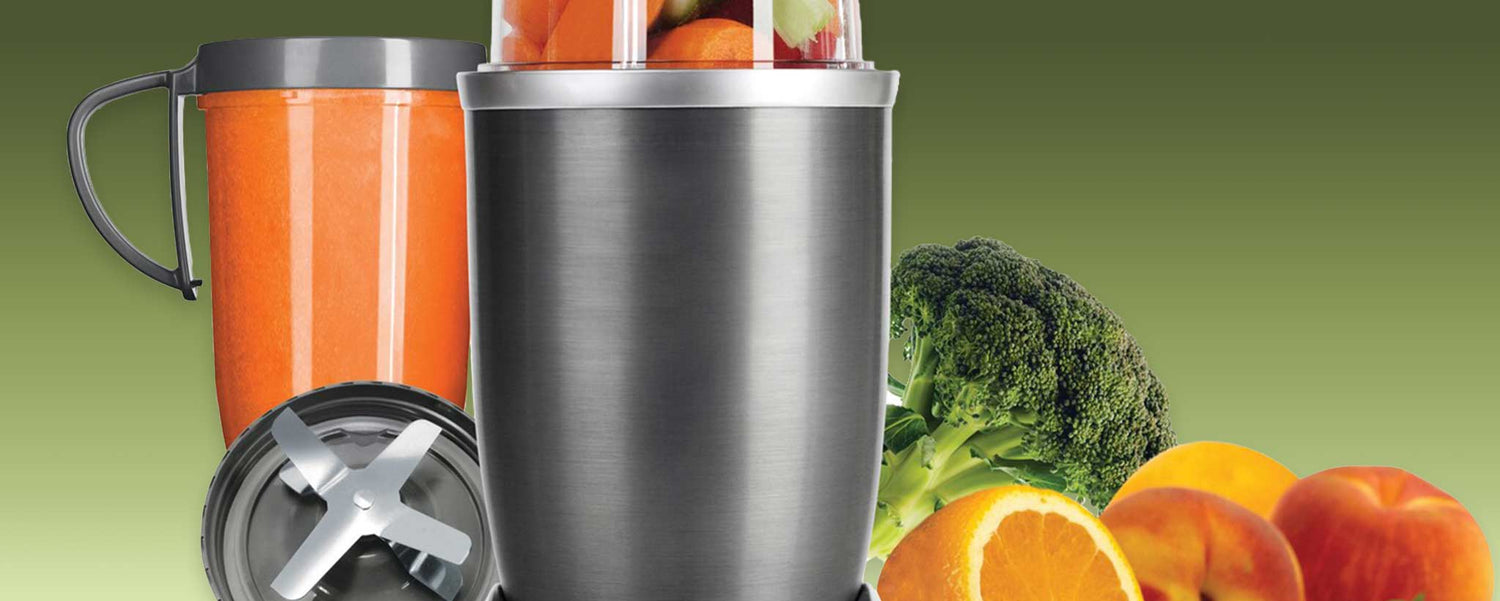Compare NutriBullet Blenders
Franchised smoothie outlets generally serve high-fructose concoctions. Healthy outlets can charge a premium for nutritious smoothies made with wholesome ingredients. At home, the quality of our smoothies is only limited by the ingredients we select and the equipment used to blend them.
We can purée with anything from a handheld immersion blender to a powerful Vitamix. Without the proper equipment, we might settle on high-calorie ice cream with protein powder to persuade ourselves to believe that it is healthy.
Already Have a Blender?
A juice extractor uses centrifugal force to separate fibrous solid matter from juice into two separate containers. I have a massive 1000-watt Breville 800JEXL juice extractor that devours carrots, celery, and whole apples. Often, I end up discarding as much plant-based solids as the juice I’m drinking. However, it is possible to freeze the solids for use in vegetable broth or to use the pulp in cakes and cookies (if you keep track of what is juiced).
Regardless, the resulting juice is not a smoothie. Juice is the fiberless liquid part of the plant, ideal for people with damaged digestive systems. Whereas a smoothie is the whole blended fruit that retains its fiber.
The typical countertop blender is adequate for speeding up the process of mixing foods. Most lack the motor strength to crush hard consumables like ice or seeds. My Osterizer 12-speed blender is 400 watts. Soft fruits with ice cream, sherbet, or yogurt mix well. I can also make dressings and sauces with this basic countertop blender. It doesn’t rust, and the blades have never been replaced, despite use for decades.
At the other end of the spectrum, a 1380-watt commercial Vitamix blender pulverizes just about everything at 37000 RPM but can cost between $400 to $1100. This is more along the lines of what you might see used in your local Starbucks coffee shop. The watts loosely correspond to power, although blade design also plays a factor. A stronger blender is larger, louder, and produces smoother results, particularly when blending fibrous vegetables, nuts, and seeds.
Bite the Bullet
A more affordable alternative to Vitamix is a mid-to-high-end Magic Bullet product. All Magic Bullet blenders include a threaded plastic cup in which you add fruit, vegetables, and liquid before screwing on the blade assembly. This fits into the motorized base that is plugged into an outlet to pulse or thoroughly blend in less than one minute. (Longer times can over-aerate or potentially overheat the motor and warm the beverage, accelerating oxidation.)
Then rinse off the blade assembly, screw a lid onto the cup, and take the blended beverage with you. These superfood-infused nutritional beverages are meal replacements called Nutriblasts.
Magic Bullet is the original 250-watt entry-level personal blender capable of grating cheese and blending smoothies with pre-shaved ice. Through infomercials, it popularized the home appliance category of personal superfood extractors. Technically, though it is still a blender, extractors separate juice from solids.
A friend uses a Magic Bullet daily to make smoothies with spinach, oats, nuts, and protein powder thickened with ice and water. That’s the thing that first impressed me because my Osterizer just spins ice around like it’s playing marbles. I wondered if the reason for his smoothie success was tied to the minimal compartment size or an extremely high torque relative to its low wattage.
A step up in power is the 600-watt NutriBullet that pulverizes seeds and nuts at 10000 RPM. An enhanced model came to market in 2014 called NutriBullet Pro, offering 25000 RPM with a 900-watt motor. Though either can break down ice cubes when mixed with liquids, they should not be used as ice crushers.
💡 NutriBullet Pro received a negative Consumer Reports review. A blade cracked or broke on two separate units during its durability test—a stress test in which seven large ice cubes are crushed 45 times (without liquid) to simulate rigorous use. The manufacturer responded that the Consumer Reports test is “a misuse of the product.” The Consumer Product Safety Commission concluded a preliminary investigation (September 26, 2014) into the NutriBullet Pro 900 blender that did not lead to regulatory action.
For greater power, you can splurge for the 2.3-horsepower, 1700-watt NutriBullet Rx with SMART Technology—pre-programmed variable speeds up to 30000 RPM. It can optionally warm your blended superfood to 150° F for soup on the go. The revolutions per minute are so high that suction cups are required on the bottom to stabilize the unit on your countertop or table. According to user reports, the motor might sound like a helicopter taking off in your kitchen.
Magic Bullet Brand Blender Comparison
| Model | Watts | RPM | Price |
| Magic Bullet | 250W | ~ | $40± |
| NutriBullet | 600W | 10K | $60± |
| NutriBullet Pro | 900W | 25K | $80± |
| NutriBullet Rx | 1700W | 30K~ | $180± |
Prices are shown in U.S. dollars. Magic Bullet products are labeled for household use only. Low-power models include more cups and lids. High-power models come with higher-capacity wide-mouth cups that can be purchased separately. Units are made in China and come with a 1-year warranty. An extended 5-year warranty is available. The manufacturer recommends replacing blades every 6 months.
There is Room For Improvement
While awaiting delivery, I had a chance to evaluate online customer comments and YouTube videos closely. Even if all complaints are due to customer error (and they are small to the praise), this product should be idiot-proof or “Apple-esque,” if that’s a more palatable expression. This is true not only for reliability but for customer safety.
The blades should not break under any (ab)normal circumstances. Perhaps they should be thicker, or better metallurgy is required. With that said, the manufacturer has reportedly improved the design of the extractor blade assembly. (I replaced the blade assembly once within 5 years, not because they broke off, but because they stopped blending adequately.)
Though I have not been able to verify it, someone complained that within the five times he used his NutriBullet Rx, the center screw that holds the blades had to be tightened twice. Rotation of blades in the high-powered NutriBullet Rx should never loosen the screw that is supposed to keep them in place (not an issue in other models).
In one video, another user mentioned that the clear nibs (three prongs activating the motor) that protrude from each cup eventually break off, requiring periodic replacement of cups. I can see that they are rather dainty. This begs the question, why couldn’t the nibs be thicker?
Concerning instructions, there is something for everyone. The User Guide and Recipe book is needlessly convoluted, in my opinion, due to inconsistent formatting. It includes multi-stage meal plans, and in the back, there is a daily journal. Someone put a great deal of thought into it. An equal amount of effort may be required to make sense of it all. The Quick-Start Guide is less intimidating, and the Pocket Nutritionist booklet is straightforward.
Most complaints about leaks might be attributed to user error—filling liquid beyond the “max” line and/or not tightening the blade assembly. Sometimes it may be necessary to taste the smoothie before adding a few ingredients until the taste is just right. When doing so, rinse the blade assembly before screwing it back on to prevent the juice from running down into the motor housing. Fiddling back and forth too much may reduce the chill of the smoothie and introduce more air into it.
Drinking a beverage through the edge of a threaded jar is possible, though slightly uncomfortable. Cleverly, a smooth lip ring can be screwed onto the cup in place of the blade assembly to avoid dirtying up another container. Alternatively, a non-spill lid can be attached. It would be nice if you could snap the lid onto the lip ring, but you can’t. Use a straw or pour it into a different commuter cup. When you take the bullet cup on the go, there is the potential to break off those protruding nibs.
All things considered, it appears that there is still room for more design improvement. Frankly, I would rather see the company work on the build quality than increase the revolutions per minute. Despite flaws reported by a minority of users, the product works. While under warranty, the company’s customer service appears accommodating. You can order replacement parts for everything from the base to the cups, lids, and gaskets.
Focusing on my purpose and the in-person demonstration seen, I splurged my DiscoverCard points to purchase the regular NutriBullet 12-piece system. (Two pieces were booklets.) Included in the box is a registration card that offers three additional months of free extended warranty service by registering online. Additionally, I ordered an extra extractor blade and a second 24-ounce cup. I recommend also buying the extended warranty, which doubles coverage when purchased with a DiscoverCard—for a decade of smoothie bliss.
Protein Shake Test
My first smoothie tested the limits of the NutriBullet. Using the dual milling blade and small cup, I blasted three tablespoons of flaxseed with one teaspoon of chia seeds into fine powder in less than 20 seconds. This easily replaces a mortar and pestle. In addition to containing many nutrients, chia seeds absorb nine times their weight in liquid (when soaked whole in water for 10 minutes) to enhance the sense of fullness. Chia seeds have no flavor of their own; they take on the taste of whatever food or drink to which they are added.
I filled the large cup with a handful of kale, a loosely chopped cored apple, carrot chunks, frozen mixed berries, frozen pineapple bits, three frozen coconut milk cubes, four ice cubes, my milled flaxseed, two tablespoons of protein powder, a tablespoon of honey, then filled the almond milk to the max line. (Note: this is not a recipe within the documentation.) The six-prong extractor blade was screwed on firmly. With a slight press and twist, the power is on. Looking through the transparent cup, it’s easy to tell when everything is well blended.
The smoothie came out perfectly thick and incredibly smooth. The only thing I could detect was some annoying raspberry seeds. If someone has a model that pulverizes these, let me know. But I think omitting this fruit is a small concession for everything else the NutriBullet does well. No juice spilled into the motor compartment. A soapy-handled brush and thorough rinse made cleanup painless. I use a simple brush that came with my Breville juicer. It is great for dislodging particles around the gasket and blades. Occasionally, remove the rubber ring for thorough cleaning.
Is There A Need For More Power?
No one wants to invest in a product only to realize that the one that truly meets their needs escaped them for a few dollars more. Conversely, spending more for needless complexity is undesirable. If speed is your definition of better, it is obvious that 30000+ RPM will win the race. Numerous YouTube videos compare models. A competitor distributes a similar line of products under the brand Ninja Bullet. There are also many (often weaker and less expensive) products from other manufacturers.
After viewing hours of videos and reading reviews, it seems that the high-power personal NutriBullet-branded blenders (and some Ninja Bullets) have more reported issues than their low-powered brethren.
Motor burnout can result from leaving units unattended. It is like driving at the freeway speed limit in second gear. The RPM is so high on these personal blenders that it rarely takes more than a minute to liquefy whatever is inside. Remember that blending too long warms the smoothie and whips more air into it, which can dilute the flavor and introduce gas in your stomach.
You might compare what is happening in this personal blender product space to the Megahertz wars in personal computers several years ago. One brand advertises 250W and another springs up offering 300W. The original company responds with 600W only to see competition tout 700W. A response with 900W is countered with 1100W. This continues beyond what is reasonably practical. The question you need to answer is, how fast does your smoothie need to be? Unless you’re driving on the Autobahn, what is the point in having a car that travels 3x the speed limit?
Consumers who are looking for a distinction often associate faster with better and smoother. Marketers feed off this for product distinction. What’s interesting is that we are not likely to taste differences without head-to-head comparisons. (On the other side of the country, I am certain someone else is singing praises over the smoothness of their drinks made using the NutriBullet Rx.)
The 600-watt NutriBullet has more power than my Osterizer blender. It can bust flaxseed into meals, rip open frozen fruits, and liquefy kale and whole carrots. It allows me to grind coffee beans, make nut butters, dips, and dressings in addition to smoothies. Most importantly, the NutriBullet makes “Nutriblasts” that are easily assimilated by my digestive system. So for my needs, it’s a winner, despite some negative reports.
You are likely to find above-average satisfaction with a NutriBullet.
In summary, it appears that high-RPM personal blenders can suffer from more rapid equipment failure. If speed is your criteria for greatness, buy a durable commercial blender. If you plan to blend multiple times per day, it will be a good investment.
If you want to use a personal blender as a dedicated ice crusher, heed the advice of Consumer Reports and choose a Ninja brand. But for personal smoothies (or frozen mixed cocktails), you are likely to find above-average satisfaction with a NutriBullet.
To support the writing of useful articles about food, ClinicalPosters sells human anatomy charts, scientific posters, and other products online. You may sponsor specific articles, become a ClinicalNovellas Member, or remit a small donation.
ClinicalPosters sells human anatomy charts, scientific posters, and other products online to offset expense of the writing useful articles about food. Slide extra posters into DeuPair Frames without removing from the wall.
Show your support by donating, shopping for ClinicalPins, becoming a ClinicalNovellas Member, or leaving an encouraging comment to keep the research going.
To support the writing of useful articles about food, ClinicalPosters sells human anatomy charts, scientific posters, and other products online. You may sponsor specific articles or remit a small donation.
ClinicalPosters sells human anatomy charts, scientific posters, and other products online to offset expense of the writing useful articles about food. Slide extra posters into DeuPair Frames without removing from the wall.
ClinicalPosters sells human anatomy charts, scientific posters, and other products online. You may remit a small donation or become a ClinicalNovellas Member.
You can support the writing of useful articles about food by sponsoring specific articles, becoming a ClinicalNovellas Member, or remitting a small donation.







 Romance & Health Intertwine. Fall in love with a captivating romance miniseries that explores the essence of well-being. Become a ClinicalNovellas member for heartwarming tales.
Romance & Health Intertwine. Fall in love with a captivating romance miniseries that explores the essence of well-being. Become a ClinicalNovellas member for heartwarming tales.






